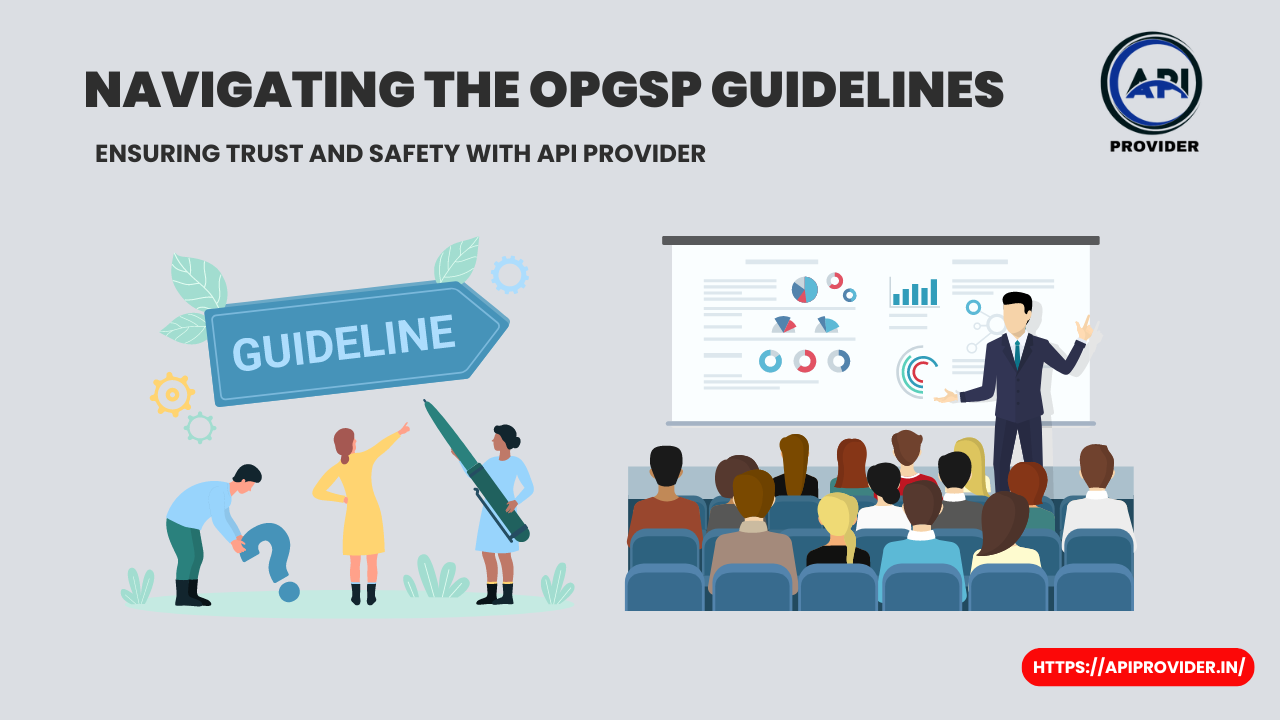Navigating the OPGSP Guidelines: In the digital age, secure and efficient online payment systems are the backbone of e-commerce. The guidelines provided by OPGSP (Online Payment Gateway Service Provider) are crucial in ensuring that online transactions are not only smooth but also secure. This guide aims to elucidate the importance of OPGSP guidelines, the role of API providers, and how businesses can navigate these guidelines to build trust and ensure safety.

Understanding OPGSP (Online Payment Gateway Service Provider)
Definition of OPGSP
OPGSPs are entities that facilitate online transactions by providing payment gateways. These gateways act as intermediaries between merchants and financial institutions, ensuring that payment information is securely transmitted and processed.
Read More….
- Verify Aadhaar Details With API Provider
- Understanding Core Banking Solution (CBS): A Comprehensive Guide
Role of OPGSP in E-commerce
OPGSPs play a pivotal role in e-commerce by:
- Enabling secure transactions between buyers and sellers
- Providing various payment options
- Ensuring compliance with financial regulations
Key Features of OPGSP
Key features of an effective OPGSP include:
- Robust security measures
- High transaction speed
- User-friendly interfaces
- Comprehensive transaction monitoring
Why OPGSP Guidelines are Essential
Ensuring Security in Transactions
The primary goal of OPGSP guidelines is to safeguard sensitive financial information, thereby preventing fraud and unauthorized access.
Enhancing Trust among Users
Adhering to OPGSP guidelines helps in building trust with users, as they are assured that their transactions are secure.
Compliance with Regulatory Standards
OPGSP guidelines ensure that payment gateways comply with regional and international financial regulations, avoiding legal issues and penalties.
Core Components of OPGSP Guidelines
Data Security and Privacy
Data security and privacy are at the core of OPGSP guidelines. This includes encryption, secure storage of payment data, and strict access controls.
Transaction Monitoring
Continuous monitoring of transactions helps in detecting and preventing fraudulent activities in real-time.
User Authentication
Strong user authentication mechanisms, such as two-factor authentication (2FA), are crucial in verifying the identity of users and preventing unauthorized access.
API Providers and Their Role
Definition of API (Application Programming Interface)
APIs allow different software systems to communicate with each other, enabling seamless integration of various services.
How API Providers Facilitate Online Payments
API providers offer tools and protocols that enable merchants to integrate payment gateways into their websites or apps, ensuring smooth and secure payment processing.
Popular API Providers in the Market
Some well-known API providers include:
- PayPal
- Stripe
- Square
- Authorize.Net
Ensuring Trust with API Providers
Evaluating API Provider’s Security Measures
When choosing an API provider, it’s essential to evaluate their security measures, such as encryption standards, compliance certifications, and security protocols.
Importance of Transparency and Accountability
API providers should be transparent about their security practices and take accountability for any breaches or issues that arise.
User Reviews and Reputation
Checking user reviews and the reputation of API providers can provide insights into their reliability and performance.
Safety Protocols for API Integration
Secure Coding Practices
Adopting secure coding practices helps in preventing vulnerabilities that could be exploited by attackers.
Regular Security Audits
Conducting regular security audits ensures that any potential security issues are identified and addressed promptly.
Encryption and Tokenization
Using encryption and tokenization techniques protects sensitive data during transmission and storage.
Compliance with OPGSP Guidelines
Understanding Compliance Requirements
It’s crucial to understand the specific compliance requirements of OPGSP guidelines, which may vary by region and industry.
Steps to Achieve Compliance
Steps to achieve compliance include conducting regular audits, updating security measures, and training staff on compliance protocols.
Benefits of Compliance
Compliance with OPGSP guidelines enhances security, builds trust with users, and avoids legal issues and penalties.
Challenges in Implementing OPGSP Guidelines
Technical Challenges
Technical challenges include integrating complex security protocols and ensuring compatibility with existing systems.
Regulatory Hurdles
Regulatory hurdles may involve navigating different regulations in various regions and ensuring compliance with all.
User Adoption and Education
Ensuring user adoption and educating them about security practices is crucial for the successful implementation of OPGSP guidelines.
Best Practices for API Providers
Maintaining Up-to-Date Documentation
Providing up-to-date documentation helps developers integrate APIs smoothly and securely.
Providing Robust Customer Support
Offering robust customer support ensures that any issues or queries are addressed promptly, enhancing user experience.
Ensuring High Availability and Reliability
Ensuring high availability and reliability of the API services is crucial for maintaining trust and ensuring smooth transactions.
Case Studies of Successful OPGSP Integration
E-commerce Platform Case Study
An e-commerce platform successfully integrated an OPGSP by following the guidelines, resulting in increased security and customer trust.
Mobile Payment App Case Study
A mobile payment app leveraged an API provider to facilitate secure and seamless transactions, enhancing user satisfaction.
International Payment Gateway Case Study
An international payment gateway ensured compliance with OPGSP guidelines, resulting in smooth cross-border transactions and regulatory compliance.
Future Trends in OPGSP and API Providers
Advancements in AI and Machine Learning
AI and machine learning are being used to enhance security measures and detect fraudulent activities more effectively.
Blockchain and Decentralized Payment Systems
Blockchain technology is revolutionizing payment systems by providing secure and transparent transactions.
Increasing Focus on User Experience
Future trends indicate an increasing focus on enhancing user experience through seamless and intuitive payment interfaces.
Step-by-Step Guide to Integrating an OPGSP with an API
Preparing for Integration
- Choose a reliable API provider.
- Gather all necessary documentation and credentials.
- Plan the integration process, including timelines and milestones.
Setting Up the API
- Implement secure coding practices.
- Integrate the API into your platform.
- Test the integration thoroughly to ensure functionality and security.
Testing and Launching
- Conduct rigorous testing to identify and fix any issues.
- Launch the integration in a controlled environment.
- Monitor the integration post-launch to ensure smooth operation.
Common Mistakes to Avoid
Ignoring Security Protocols
Neglecting security protocols can lead to vulnerabilities and breaches.
Skipping Regular Updates
Regular updates are crucial for maintaining security and functionality.
Overlooking User Feedback
User feedback provides valuable insights into potential issues and areas for improvement.
